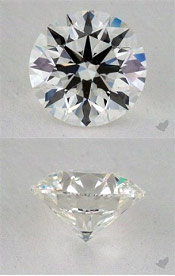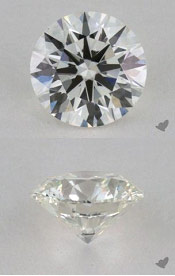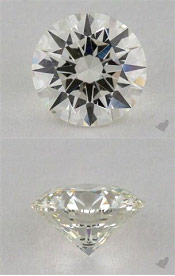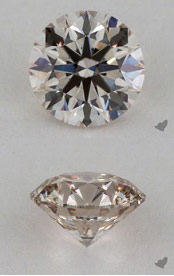Color - The 4Cs of Diamonds
Diamond Color
When shopping for a diamond, it is generally preferred to choose a stone with the least amount of color possible. Diamond color is graded on a scale from D-Z and is divided into five broad categories (colorless, near colorless, faint, very light and light). Diamonds come in all colors of the spectrum. The predominant color you see in a diamond is yellow, which is caused by the trace element nitrogen.
Generally, when comparing color between two diamonds, the diamonds need to be at least two color grades apart to even begin to see a difference. As you can see from the images below, when diamonds are in the face up position it is almost impossible to see any color. When viewing the diamond from the side profile, you may start to detect some color; however, diamonds are admired for their beauty from the face up position and not the side.
Colorless Diamonds (D-F):
Diamonds within the colorless range are the most rare and valuable of all those on the color scale. D/E color stones display virtually no color, whereas F colored diamonds will display a nearly undetected amount of color when viewed face down by a gemologist.
D Color E Color F ColorNear Colorless Diamonds (G-J):
Diamonds within the near colorless range appear colorless in the face up position, but do display a slight amount of color when viewed face down against a perfectly white background. This trace amount of color will be undetectable to an untrained eye once the diamond has been mounted. Near colorless diamonds offer a tremendous value for their price.



 G Color
H Color
I Color
J Color
G Color
H Color
I Color
J Color
Faint Color Diamonds (K):
Diamonds within the faint color category may show a slight hint color when viewed in the face up position; however, these are another wonderful option for those who are not sensitive to color. Some even love the color scheme that is displayed from these diamonds.
 K Color
K Color
While the most predominant color found in a diamond is yellow, it’s not uncommon for a diamond to take on a brown color. This is thought to be caused by internal graining, which results from structural irregularities often in combination with an impurity like nitrogen.




 Start with a setting
Start with a setting
 Solitaire
Solitaire Pavé
Pavé Channel-Set
Channel-Set Halo
Halo Side-stone
Side-stone Platinum
Platinum
 Yellow Gold
Yellow Gold
 Rose Gold
Rose Gold
 White Gold
White Gold
 Classic Wedding Bands
Classic Wedding Bands
 Eternity Bands
Eternity Bands
 Diamond Bands
Diamond Bands
 Stackable Bands
Stackable Bands
 Carved Bands
Carved Bands
 Alternative Metal Bands
Alternative Metal Bands
 Eternity Bands
Eternity Bands
 Anniversary Rings
Anniversary Rings
 Diamond Studs
Diamond Studs
 Diamond Pendants
Diamond Pendants
 Tennis Bracelets
Tennis Bracelets
 Earrings
Earrings
 Gemstone Earrings
Gemstone Earrings
 Pearl Earrings
Pearl Earrings
 Gemstone Necklaces
Gemstone Necklaces
 Pearl Necklaces
Pearl Necklaces
 Diamond Bracelets
Diamond Bracelets
 Gemstone Bracelets
Gemstone Bracelets
 Diamond Rings
Diamond Rings
 Gemstone Rings
Gemstone Rings







Leave a comment